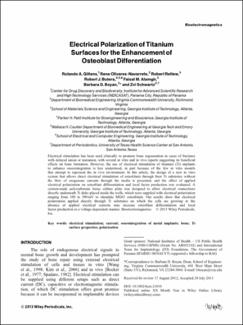| dc.contributor.author | Gittens, Rolando A. | |
| dc.contributor.author | Olivares-Navarrete, Rene | |
| dc.contributor.author | Rettew, Robert | |
| dc.contributor.author | Butera, Robert J. | |
| dc.contributor.author | Alamgir, Faisal M. | |
| dc.contributor.author | Boyan, Barbara D. | |
| dc.contributor.author | Schwartz, Zvi | |
| dc.date.accessioned | 2020-08-08T17:48:19Z | |
| dc.date.available | 2020-08-08T17:48:19Z | |
| dc.date.issued | 2013-08-29 | |
| dc.identifier.other | doi.org/10.1002/bem.21810 | |
| dc.identifier.uri | http://repositorio-indicasat.org.pa/handle/123456789/229 | |
| dc.description | Electrical stimulation has been used clinically to promote bone regeneration in cases of fractures with delayed union or nonunion, with several in vitro and in vivo reports suggesting its beneficial effects on bone formation. However, the use of electrical stimulation of titanium (Ti) implants to enhance osseointegration is less understood, in part because of the few in vitro models that attempt to represent the in vivo environment. In this article, the design of a new in vitro system that allows direct electrical stimulation of osteoblasts through their Ti substrates without the flow of exogenous currents through the media is presented, and the effect of applied electrical polarization on osteoblast differentiation and local factor production was evaluated. A custom-made polycarbonate tissue culture plate was designed to allow electrical connections directly underneath Ti disks placed inside the wells, which were supplied with electrical polarization ranging from 100 to 500 mV to stimulate MG63 osteoblasts. Our results show that electrical polarization applied directly through Ti substrates on which the cells are growing in the absence of applied electrical currents may increase osteoblast differentiation and local factor production in a voltage-dependent manner. Bioelectromagnetics © 2013 Wiley Periodicals, Inc | en_US |
| dc.description.abstract | Electrical stimulation has been used clinically to promote bone regeneration in cases of fractures with delayed union or nonunion, with several in vitro and in vivo reports suggesting its beneficial effects on bone formation. However, the use of electrical stimulation of titanium (Ti) implants to enhance osseointegration is less understood, in part because of the few in vitro models that attempt to represent the in vivo environment. In this article, the design of a new in vitro system that allows direct electrical stimulation of osteoblasts through their Ti substrates without the flow of exogenous currents through the media is presented, and the effect of applied electrical polarization on osteoblast differentiation and local factor production was evaluated. A custom-made polycarbonate tissue culture plate was designed to allow electrical connections directly underneath Ti disks placed inside the wells, which were supplied with electrical polarization ranging from 100 to 500 mV to stimulate MG63 osteoblasts. Our results show that electrical polarization applied directly through Ti substrates on which the cells are growing in the absence of applied electrical currents may increase osteoblast differentiation and local factor production in a voltage-dependent manner. Bioelectromagnetics © 2013 Wiley Periodicals, Inc | en_US |
| dc.format | application/pdf | |
| dc.language.iso | eng | en_US |
| dc.rights | Info:eu-repo/semantics/openAccess | |
| dc.rights | https://creativecommons.org/licenses/by/4.0/deed.es | |
| dc.subject | electrical stimulation | en_US |
| dc.subject | current | en_US |
| dc.subject | osseointegration of metal | en_US |
| dc.subject | implants | en_US |
| dc.subject | bone | en_US |
| dc.subject | Ti surface properties | en_US |
| dc.subject | polarization | en_US |
| dc.title | Electrical Polarization of Titanium Surfacesfor the Enhancement of Osteoblast Differentiation | en_US |
| dc.type | info:eu-repo/semantics/article | en_US |
| dc.type | Info:eu-repo/semantics/publishedversion | |

